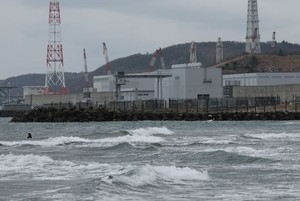By TOMOKO ADACHI/ Staff Writer
June 4, 2022 at 07:00 JST
FUJISAWA, Kanagawa Prefecture--A sculptor has almost completed a nearly 10-meter-tall wooden statue of Virgin Mary that he started carving 40 years ago to pray for the souls of thousands of people killed in Kyushu in the 17th century.
Eiji Oyamatsu, 88, who has an atelier in Fujisawa, Kanagawa Prefecture, is working alone on the statue and using his own money.
Volunteers in Minami-Shimabara, Nagasaki Prefecture, were so moved by Oyamatsu’s enthusiasm that they decided to build a dedicated facility for the statue and plan to start housing it there in late June.
“It seems fateful that I set about this work without being commissioned by anybody, and the statue will now be hosted in a place that deserves it the most,” the sculptor said.
The Shimabara Rebellion swept across broad areas of what are now Nagasaki and Kumamoto prefectures in 1637-1638.
Christians and farmers holed up in Hara Castle to confront troops sent by the Tokugawa Shogunate. More than 30,000 of the rebels were killed there, according to estimates.
The remains of Hara Castle are located in Minami-Shimabara.
PRIZE-WINNING ARTIST
Oyamatsu is a native of Sado, Niigata Prefecture.
After graduating from high school, he studied under Shodo Sasaki (1882-1961), a lost-wax casting artist and a government-designated “living human treasure,” who was also from Sado.
Oyamatsu later trained as a live-in apprentice to wood carver Choshu Hashimoto (1899-1960) and moved his base to Fujisawa during the 1970s.
He won the top “prime minister’s prize” at the Japan Fine Arts Exhibition (Nitten) in 2011.
A POPE’S BLESSING
The sculptor, a Roman Catholic, had visited the remains of Hara Castle around 1971 and was struck by the absence of memorial monuments or other similar facilities at the site.
He decided to make the gigantic statue of Virgin Mary as a memorial in 1981, when John Paul II became the first pope to visit Japan, with Nagasaki included in his itinerary.
Oyamatsu first created a 50-centimeter-tall “Virgin and Child” statue, showing St. Mary with Jesus Christ in her arms.
He sent the statue to the pope, along with a letter carrying the carver’s feelings and thoughts.
Oyamatsu later received a reply, saying the pope was blessing his life and his work. The pope’s benediction provided a huge moral support.
Oyamatsu proceeded to make gradually larger images measuring 2.5 meters and 6 meters tall until he set about working on the current statue measuring 9.5 meters in height.
Its pedestal alone is 3 meters tall and 2.5 meters wide.
A tree that size is difficult to come by, so Oyamatsu has made the statue in log-house style, interlocking round slices of camphor tree.
After finishing his regular work for the day, he often chisels Madonna statues, even at the cost of sleep.
He also insists on working solo on the project, and he has declined all offers of assistance or funding.
“I want to see how far I can go with my own abilities,” Oyamatsu said. “A climber wouldn’t have much fun if he were to take a helicopter to the summit, right?”
His work on the Virgin Mary statue became known to residents in Minami-Shimabara.
SITE PREPARED IN NAGASAKI PREFECTURE
Oyamatsu in 2015 decided to donate the statue to the Minami-Shimabara city government, but some citizens objected to the plan, saying it went against the separation of religion and politics.
With the future of the statue unclear, the volunteer group in 2020 set up the Citizens’ Association for the Minami-Shimabara World Heritage, a general incorporated association, and sought donations to reactivate the plan.
“We were deeply moved by the earnest feelings of the artist,” said an official with the association’s secretariat. “And the more you look, the more you realize it’s a wonderful work. We want to host the statue here in Minami-Shimabara at any price.”
The total cost of transportation and installation is estimated at around 100 million yen ($770,000).
Construction of a main tower for housing the Virgin Mary statue started in April on a hillock through the 30 million yen or so that had been donated so far. The tower is expected to be completed in late June.
The site offers a sweeping view of the remains of Hara Castle, which were named as part of a UNESCO World Heritage site in 2018, and of the Amakusa Islands across a strait, which were also embroiled in the Shimabara Rebellion.
Oyamatsu named his statue the “St. Mary Kannon of Hara Castle.”
The name contains reference to Maria Kannon, or images of Virgin Mary in the guise of the Kannon deity of Buddhism, which hidden Christians in the area worshipped when Christianity was banned in Japan from the 17th through 19th century.
Oyamatsu will enter the enshrinement site when his statue is brought there. He will then assemble the parts, take anti-earthquake measures, and add the finishing touches, including coloration. The work is expected to take about three months.
“I am still being nervous because some parts may not fit when they are actually assembled on site,” the sculptor said. “Far from feeling relieved that the hardest part of the work is over, I have a prickling pain in my stomach.”
The statue is expected to go on public display in spring next year.




















A peek through the music industry’s curtain at the producers who harnessed social media to help their idols go global.
A series based on diplomatic documents declassified by Japan’s Foreign Ministry
Here is a collection of first-hand accounts by “hibakusha” atomic bomb survivors.
Cooking experts, chefs and others involved in the field of food introduce their special recipes intertwined with their paths in life.
A series about Japanese-Americans and their memories of World War II